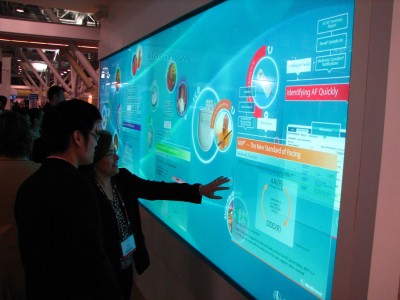Social networking
Other DOOH campaigns have achieved success by tying in with social media for marketing purposes.

GestureTek, based in Toronto, adds gesture-based interactivity to a range of dynamic displays. Photo courtesy GestureTek
“This fusion of OOH and online social networks is powerful in helping extend the reach of brands and advertisers,” says LocaModa’s King, “while offering consumers the benefit of connecting seamlessly with their peers, whether they are at the same venue or in distant locations.”
Extending the reach of an initial OOH campaign to the web through social networking features, King claims, can deliver more overall impressions than an OOH project could on a stand-alone basis. Several years ago, his company calculated a generic text message campaign via a digital signage network comprising 1,000 bars, for example, would generate 60,750 messages from consumers per month, whereas a localized campaign connected to a social network would yield 431,000 messages per month.
LocaModa’s past efforts to bring social networking to digital signage have allowed consumers to interact, via their mobile phones, with content on large screens in coffee shops and other locations, then transfer those interactive experiences to Facebook and other social networking sites. Thus, a customer in a social setting like a bar could interact not only with fellow patrons in the same venue, but also with friends elsewhere online.
Customers can also to choose to respond, via text messages, to an interactive ‘call to action’ within a digital sign ad, then see their responses instantly posted on that venue’s social network pages and news feeds. LocaModa and OOH ad agency Posterscope have found these and other social media applications are an ideal way to run an advocacy campaign or offer consumer rewards and are beneficial in creating greater audience engagement.
In 2010, the Italian clothing company Diesel ran a two-week ‘Be Stupid’ multi-platform campaign in Denmark, developed by Comtech Experience using Never.no software. Centred on the theme of “the relentless pursuit of a regret-free life,” the branding project invited the public to submit photos of themselves and their friends in amusing and playful poses, which were then displayed on Facebook, digital signs in Diesel stores and projected wall surfaces in Copenhagen simultaneously.
The advertiser was prepared to let anything happen, with the campaign using only real-time content moderation.
“One of the goals was getting customers more involved with the brand,” says Karsten Solaas, managing director of Comtech. “Another key goal was building a longer-term relationship by attracting members to their Facebook group. The campaign succeeded in generating a great deal of activity through that group.”





